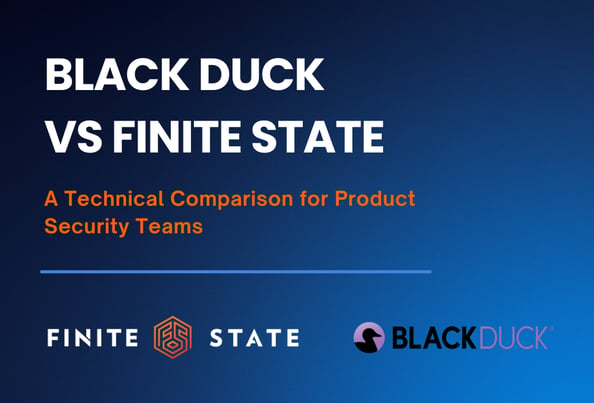Amid today’s proliferation of cyber threats, how can organizations confront the challenges of ensuring that their software remains both secure and compliant?
In this new ecosystem of ever-increasing risks and requirements, software security has emerged as a critical lifeline for businesses and individuals alike. The Finite State Next Generation Platform offers cutting-edge solutions for one of the most challenging aspects of software security: analyzing software binary files.
But what does this entail? How does Finite State help you perform Static Application Security Testing (SAST) against software binary files to identify vulnerabilities, security weaknesses, and compliance issues? And, in the complex world of Binary Software Composition Analysis (SCA), how does Finite State navigate the intricacies of third-party components within these binary files?
In this blog post, we’ll delve into each of these questions. We'll explore where the vulnerability signatures that inform Finite State’s platform detections come from, how accuracy is ensured, and the strategies employed to avoid false positives.
Read on as we uncover the details of Finite State’s Next Generation Platform, a tool that supports comprehensive security testing efforts while blending the precision of binary Software Composition Analysis (SCA) with the thoroughness of Static Application Security Testing (SAST).
Binary Software Composition Analysis (SCA)
Finite State’s advanced binary Software Composition Analysis (SCA) capabilities deliver precision and thoroughness when analyzing software binaries. In this section, we will explore the three cornerstone aspects of Finite State’[s binary SCA approach: Accuracy, Completeness, and Relevance. Each of these facets plays a vital role in ensuring that our analysis is not just comprehensive, but also precisely tailored to the unique needs of each customer.
Accuracy: Finite State's binary SCA capabilities unpack binary firmware archives and analyze each file, individually. This deep analysis considers a series of embedded signatures, including strings, symbols, function names, and control flow graphs.
Completeness: Our platform then compares these signatures against our extensive dataset of known commercial and open-source software. Through this approach, the Finite State Next Generation Platform can determine, with precision, the software components and their versions within each binary, accommodating variations arising from different toolchains and architectures.
Relevance: This SCA process results in a detailed mapping of all software components within a binary to known vulnerabilities from over 250 sources. Our SCA process ensures that the vulnerabilities we identify are relevant to the components within the binary and come with both comprehensive details and remediation guidance.
Binary Static Application Security Testing (SAST)
Advancing Beyond Known Vulnerabilities: Binary SAST's Role in Identifying Runtime Issues: Our binary SAST process goes beyond identifying known vulnerabilities. Through binary SAST, the Finite State Next Generation Platform delivers advanced decompilation and disassembly techniques, enabling us to simulate operational conditions and identify runtime vulnerabilities.
Blending Static and Dynamic Analysis: Integrating DAST for Comprehensive Vulnerability Insights: This method effectively uncovers vulnerabilities such as buffer overflows and memory leaks, providing insights similar to DAST, but achieved through static means. Finite State's platform integrates with over 150 security testing tools, including DAST scanners, to complement our static analysis with the integration of DAST results. This allows our clients to conduct DAST scans in live or emulated environments using their chosen tools, with results being ingested into our platform for a unified analysis.
Proactive Weakness Detection: Uncovering CWEs through Detailed Data Flow Analysis: The Finite State Platform decompiles and disassembles binary files and conducts detailed data flow analysis, uncovering Common Weakness Enumerations (CWEs) that represent potential security weaknesses not cataloged as known vulnerabilities but that could lead to exploitable conditions. This proactive approach provides a comprehensive view of the software’s security posture, ensuring a comprehensive, accurate, and actionable security assessment, tailored to the specific challenges and requirements of your software.
Securing the Future with Finite State’s Next Generation Platform
The complexities and evolving challenges of today's digital landscape have brought with them the need for robust software security. Through this exploration of Finite State’s Next Generation Platform, we have uncovered the intricate and innovative ways in which the platform addresses these challenges. From the meticulous process of Binary Software Composition Analysis (SCA) focusing on Accuracy, Completeness, and Relevance, to the advanced techniques of Binary Static Application Security Testing (SAST), Finite State stands at the forefront of software security.
The journey we've taken in this post highlights the platform’s unique ability to go beyond traditional vulnerability identification, integrating state-of-the-art decompilation, disassembly, and data flow analysis. This comprehensive approach not only spots known vulnerabilities but also uncovers hidden runtime issues and potential weaknesses, providing insights that mirror Dynamic Application Security Testing (DAST) but from a static standpoint. The integration with over 150 security testing tools further strengthens this analysis, allowing for a holistic understanding of software vulnerabilities.
Finite State’s proactive approach in detecting Common Weakness Enumerations (CWEs) through detailed data flow analysis ensures that the security assessment provided is not just comprehensive but also tailored to the specific needs and challenges of each software. This level of detailed scrutiny and adaptability makes Finite State’s platform a vital ally in safeguarding software against the ever-growing spectrum of cyber threats.
The Finite State Next Generation Platform represents a paradigm shift in how we approach software security. It offers a beacon of hope and a reliable solution for organizations striving to keep their software secure and compliant in an increasingly complex and threat-prone digital world. With Finite State, organizations can confidently step into a new era of software security, armed with the tools and insights needed to protect their digital assets against the unknown challenges of tomorrow.
Subscribe to Our Blog
Get the latest posts delivered straight to your inbox weekly.
Share this
You May Also Like
These Related Stories

Industry Report: The True Costs of False Positives in Software Security

Security Processes for Connected Devices – Revisiting AppSec


